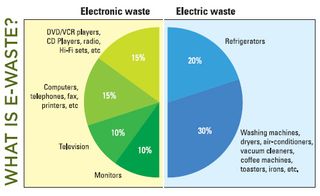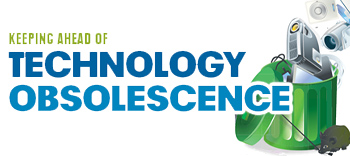No one doubts that advances in digital technology have made life easier. Devices like cell phones, laptops, space-saving flat panel monitors, and portable projectors have changed the way our world communicates. But whether at home or at work, we've all arrived at the same problem: what to do with a mountain of obsolete technology collecting dust in storage closets and desk drawers.
As more attention is paid to green living and sustainable practices, the AV industry is following the lead of the IT world in addressing the issue of obsolescence and electronic waste. In 2005, the Environmental Protection Agency (EPA) reported that discarded TVs, computers, peripherals (including printers, scanners, and faxes), mice, keyboards, and cell phones totaled about 2 million tons. Of that, about 80-85 percent was discarded primarily in landfills.
Formerly cutting-edge technology like the cathode ray tube (CRT) display should not be thrown in the trash due to high lead content. A 36- inch CRT can have 7.7 pounds of lead in the glass. Thankfully, there are recycling centers that can handle CRTs and other displays, but what about projectors, amplifiers, loudspeakers, and other AV equipment that are in the waste stream? According to the EPA, recyclers recover more than 100 million pounds of materials from electronics each year, but individual statistics do not exist specifically for AV equipment.
- SPECIFYING AV
- Delaying obsolescence on an AV project begins, well, at the beginning. Specifying AV for a large project can sometimes be a challenge, especially considering the fast pace of technology. "The timeline can be three or more years between system design and installation. We provide the infrastructure design, but also design the AV system as late in the process as possible to take advantage of any technology advancement and price decline," says Mark Alspach, principal and head of the AV group at AV consulting firm Shen Milsom & Wilke in New York City. The firm will often work on large projects with AV budgets ranging between $10 million to $20 million.
Matt Moore, a consultant with AV consulting firm Cavanaugh Tocci in Sudbury, MA, adds: "We will specify one year in advance on sound systems. On the video side, we delay specifying to the AV contractor until six to nine months to the opening. We don't necessarily push to constantly change the products since change orders can be expensive. To keep from getting caught in a constant upgrade cycle, we take a snapshot of what technology is available today."
Maintaining close watch of market availability and what products are near end-of-life are strategies that Alspach and his team employ. "We'll get a roadmap of products and the follow-on products from manufacturers. Technologies that are most volatile, like video, are the ones that we have to spend time following to ensure the product is not at end-of-life at the time of purchase," he says.
For projects that are renovations or retrofits, Alspach will add value by helping the client know what it is worth being reused. Moore agrees, "We will try to repurpose some products or use them in another venue. If it's been upgraded in the past five years, we will advise the client to try and keep it." However, proper recycling of old technology is still not part of the upfront process. "It is hard to focus on AV equipment rather than IT equipment, which has a greater volume (but less variety). AV is a zillion different things between monitors, DVD players, amplifiers, speakers, and so on," says Alspach. "Other options [for getting rid of old gear] are donations or liquidating to integrators or resellers, but a lot of old equipment still goes in the trash."
MINIMIZING RISK, MAXIMIZING SAVINGS
Unfortunately, the answer to the question of when to replace obsolete technology depends on many factors. What is obsolete to one company may be a technological gift to another person or organization. As Alspach notes, "The word obsolete has a negative connotation, as if the product wasn't good. Many times that is not the case; a 5,000-lumen projector still does its job even though there may be a newer model."
For Steve Wilson, IT manager of coatings company Cincinnati Thermal Spray in Cincinnati, OH, personal computers more than three years old are slated for either replacement or a refresh of the operating system. "We will identify 'power users' like developers or engineers and will repurpose their old machines for other departments requiring less processing power. By repurposing, we can get another couple years out of the equipment," says Wilson, who handles AV and IT for the company's four locations and oversees a range of technology, including personal computers, thin clients, video displays, PDAs, cell phones, and industrial automation tools like CNC machines and robotics. "If I can reuse it, I will."
But when end-of-life does come, Wilson has several methods for the disposal of obsolete technology. "About three years ago, our local county government sponsored a recycling day. There was no cost for recycling, but you had to get your equipment to the site yourself," says Wilson. "We hired a truck and unloaded seven or eight pallets of gear."
Wilson has also tried an employee lottery. A recent lottery of CRTs saw 10 of the 12 offered displays go home with employees. Wilson has also repurposed older computers for employee communication. "We purchased a 42-inch LCD and are using an old PC to drive the content as an ad-hoc digital signage system," he says.

Ted Leamy, chief operating officer of Promedia/Ultrasound, a live sound touring operator and installed sound contractor in the San Francisco Bay area, recommends focusing on the infrastructure rather than the human interface (like projectors, touchscreens, and LCDs), which changes rapidly. "It is easier to get a good return on investment for loudspeakers versus smaller accessories like microphones and small mixers. And a good amplifier is a good amplifier, even 10 years from now," he says. "The core of the system is a good investment. Think about spending money to future-proof the infrastructure; invest as much as you can in the backbone. Don't install Cat5 cable when Cat6 or fiber will be the standard in a few years."
Leamy suggests that if loudspeakers are chosen for reliability and longevity, as well as performance value and cost, then they can also be an integral part of the infrastructure. "There are many loudspeaker systems that are ten years old or more. I consider that a good investment in infrastructure, especially in our current times of disposable goods," he says.
As for recognizing which technology is here to stay, Leamy says, "When technologies are adopted by a broad spectrum of the market, it is a good sign that technology will be around for a while. When manufacturers invest heavily into a technology due to mass adoption, there is a pretty good chance that technology will be around for a while."
Some companies turn to leasing to minimize technology investment risk and to guard against getting stuck with obsolete technology. "Leasing is an option as long as you have an exit strategy. You can get in for 3 percent down and a dollar buyout, but leasing is not a panacea," says Leamy. "For purchases over $100,000, a lease may be a better option than a bank loan, but you must also look at total cost of ownership. It is the cost of the equipment plus integration and accessories. And at the end of its life, the equipment may be worth nothing."
Wilson adds, "Leasing comes down to accounting. To me, leasing makes a lot of sense. Companies like Cisco have a leasing program where they take back the old technology and resell it so you have a guaranteed buyback value upfront."
OPTIONS FOR AV EQUIPMENT
The sobering fact is that the world is facing an increasing deluge of electronic waste. The EPA states that almost 50 percent of electronics sold between 1980 and 2004 are still in use or reuse, and 9 percent of products sold during that time are still in storage. That majority percentage (59 percent) translates into hundreds of millions of pounds, a volume that would easily overwhelm recyclers today. "But the network for electronic product recyclers is growing," says David Thompson, director of corporate environmental affairs for display manufacturer Panasonic. Thompson is also president of the Electronic Manufacturers Recycling Management Company, LLC (MRM), an electronics recycling organization spearheaded by Panasonic.

According to Thompson, electronics recycling compliance varies from state to state, but generally follows either a return share model or a sales model. "In Maine, recycling efforts are focused on home or small business e-waste. In California, the emphasis is on display technology like LCDs or CRTs, but recyclers will not accept medical equipment or cars. Funding is from an advance recycling fee at point of sale, and business waste is not covered," he says. "In Minnesota, manufacturers must collect 60 percent of the weight of goods sold, but the state does not enforce how to collect the products. In Minnesota, business waste is covered." Several states, such as Maine, Maryland, Minnesota, New Jersey, North Carolina, and Texas, define business waste as any waste that is not generated by a household. "These states have excluded business waste based on this type of definition," adds Thompson.
In Washington State, the manufacturer's responsibility is based on returns and current sales. "Washington takes an average of both and tasks the manufacturer with paying a fee to a government-sanctioned agency for recycling," says Thompson. "In New York City, any manufacturer wishing to sell products has to have a collection program approved by the New York Department of Sanitation."
The varying state laws exist due to the lack of cohesive direction from the federal government. Thompson notes, "The laws are being rewritten from the 1970s to cover ewaste, or universal waste as it is called. Laws thus far have focused on display technology due to lead content in the glass of devices like CRT displays. LCDs have mercury in the back light and older plasmas have a small amount of lead in the glass."
Businesses that are looking to unload a large amount of obsolete technology may have to look for private recyclers. "Most local governments don't have permits to collect business waste," says Thompson. "I would guess that the primary reason they do not cover business waste is the volume."
For their part, Panasonic developed leadfree glass material for its plasma televisions and monitors with properties similar to lead oxide glass used in CRT video displays. According to the company, the new screens will result in the worldwide reduction of close to 300 metric tons of lead, the approximate weight of two 747 commercial airliners, every year. The lead-free glass also makes the recycling process safer for workers.
As AV technology advances, it will take an organized, group effort from manufacturers, system designers, installers, and end users to effectively manage the waste created by obsolete technology. Thompson advises, "Before you buy, talk to the manufacturer about environmental attributes like potential recyclability and energy efficiency."
Linda Seid Frembes is a journalist and public relations consultant for the pro AV community. Visit her atwww.frembes.com.










